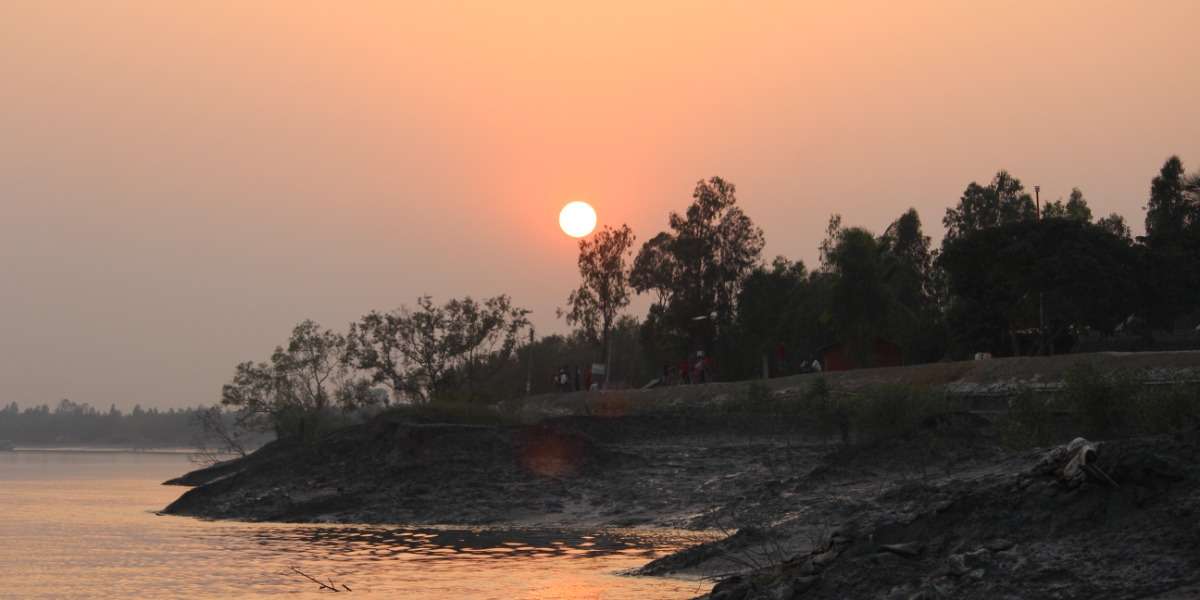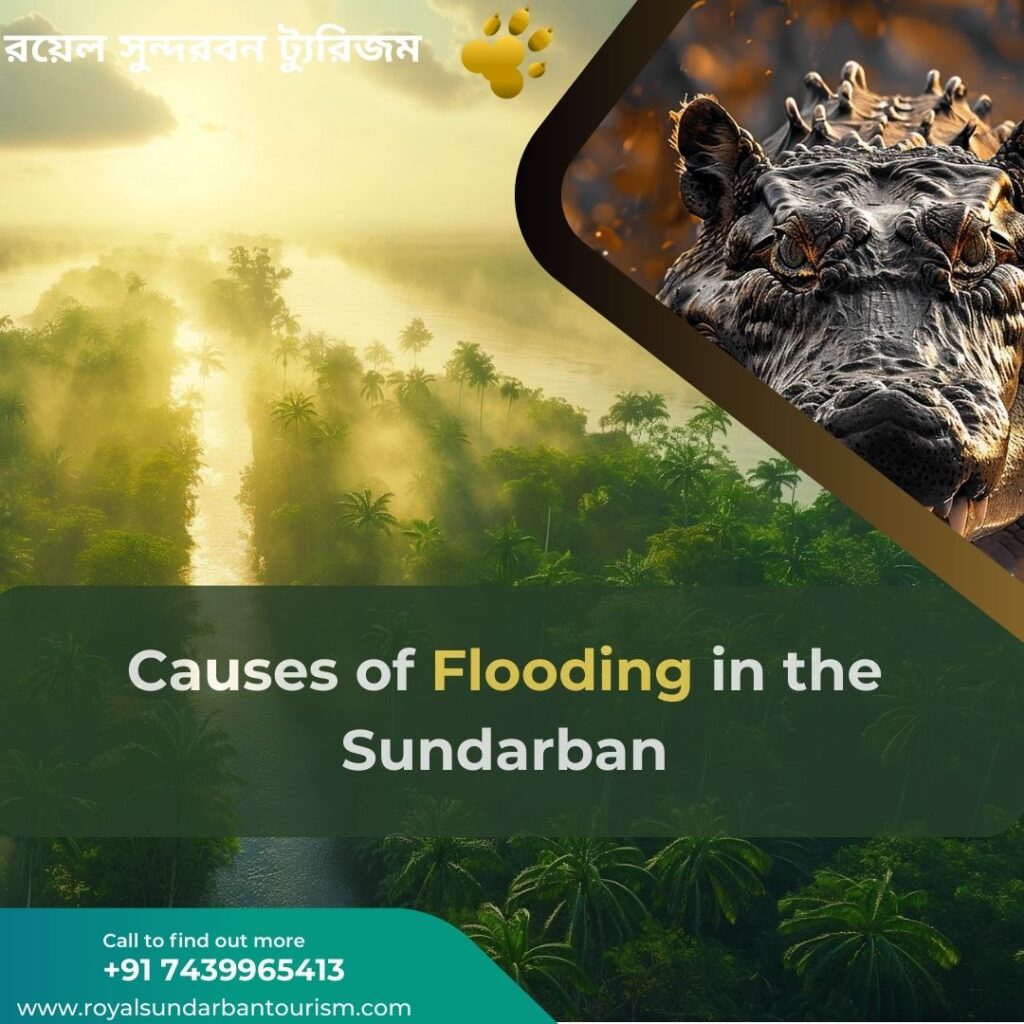Causes of Flooding in the Sundarban: The Sundarbans, a vast mangrove forest located in the delta region of the Ganges, Brahmaputra, and Meghna rivers, is no stranger to flooding. This natural phenomenon, while essential for the ecosystem’s health, can also pose significant challenges to the local communities and wildlife inhabiting the region. In this comprehensive blog, we will explore the various factors contributing to flooding in the Sundarbans, its impact on the environment and inhabitants, and how Royal Sundarban Tourism navigates these challenges to offer unique tour experiences. We can see more details about “Causes of Flooding in the Sundarban” in this blog.

The Sundarbans: A Flood-Prone Ecosystem
Geological Formation
The Sundarbans, formed by the convergence of three major rivers, is inherently susceptible to flooding due to its low-lying topography. The region’s extensive network of tidal waterways and marshy terrain exacerbates the inundation during monsoon seasons and cyclonic events.
Monsoon Rains
The primary driver of flooding in the Sundarbans is the annual monsoon season, which brings heavy rainfall to the region from June to September. The monsoon rains, coupled with high tides and storm surges, lead to riverbank erosion and inundation of low-lying areas, including the mangrove forests and adjacent villages.

Cyclonic Storms
The Sundarbans is prone to cyclonic storms originating in the Bay of Bengal, especially during the pre-monsoon and post-monsoon periods. These intense weather systems bring torrential rains, strong winds, and storm surges, resulting in widespread flooding, infrastructure damage, and loss of lives. Also, you can Book the Sundarban Tour At Maity Tourism and Sundarban Leisure Tourism Powered By Argusdna,
Human Activities and Climate Change
Deforestation and Land Conversion
Human activities such as deforestation, agricultural expansion, and urbanization have altered the natural drainage patterns of the Sundarbans, exacerbating flood risks. The clearing of mangrove forests for shrimp farming and industrial development has reduced the region’s natural resilience to flooding and increased vulnerability to erosion and saltwater intrusion. We can find more details about “Causes of Flooding in the Sundarban” in this blog.

Climate Change Impacts
Climate change-induced sea-level rise and changes in precipitation patterns further exacerbate flooding in the Sundarbans. Rising sea levels lead to saltwater intrusion into freshwater ecosystems, affecting vegetation growth and disrupting the delicate balance of the mangrove ecosystem. Erratic rainfall patterns and more frequent extreme weather events intensify the frequency and severity of floods, posing significant challenges to the region’s resilience.
Read More:
| River Crossings and Ganga Adventures |
| Safety and Comfort in the Sundarbans |
| Tailored Experiences with Royal Sundarban Tourism |
| Tracking Wildlife with Royal Sundarban Tourism Guides |
Impact on Environment and Communities
Biodiversity Loss
Flooding in the Sundarbans can have profound ecological consequences, including habitat loss, soil erosion, and biodiversity loss. Mangrove trees, crucial for stabilizing soil and providing habitat for diverse flora and fauna, are particularly vulnerable to inundation and saltwater intrusion, leading to die-offs and habitat degradation.

Human Settlements
The Sundarbans is home to millions of people living in densely populated villages and towns along the riverbanks. Flooding poses significant risks to these communities, resulting in displacement, loss of livelihoods, and damage to infrastructure. Vulnerable populations, including women, children, and the elderly, are particularly at risk during flood events.
Royal Sundarban Tourism: Navigating Flood Challenges
Expert Guided Tours
Despite the challenges posed by flooding, Royal Sundarban Tourism continues to offer expert-guided tours that showcase the unique beauty and biodiversity of the Sundarbans. Experienced guides accompany visitors on carefully curated excursions, ensuring their safety and providing valuable insights into the region’s ecology and culture.
Sustainable Practices
Royal Sundarban Tourism is committed to sustainable tourism practices that minimize environmental impact and support local communities. By promoting responsible tourism initiatives such as eco-friendly accommodations, waste management, and community engagement, the company aims to mitigate the adverse effects of flooding on the Sundarbans ecosystem. We can see more details about “Causes of Flooding in the Sundarban” in this blog.

Adaptation and Resilience
In the face of increasing flood risks, Royal Sundarban Tourism prioritizes adaptation and resilience-building measures to safeguard guests and staff. Comprehensive risk assessments, emergency preparedness plans, and continuous monitoring of weather and river conditions are integral components of their operational framework.
Frequently Asked Questions (FAQ) About Causes of Flooding in the Sundarban
1. Are Sundarbans tours affected by flooding?
While flooding can impact access to certain areas of the Sundarbans during the monsoon season, Royal Sundarban Tourism carefully monitors weather conditions and adjusts tour itineraries accordingly to ensure the safety and comfort of guests. We can check more details about “Causes of Flooding in the Sundarban” in this blog.
2. What precautions should visitors take during floods?
Visitors should follow the guidance of their tour guides, stay informed about weather forecasts, and carry essential items such as rain gear, mosquito repellent, and emergency supplies. It is essential to remain flexible and patient in the event of itinerary changes due to flooding.

3. How does Royal Sundarban Tourism contribute to flood resilience?
Royal Sundarban Tourism implements sustainable tourism practices, supports local conservation initiatives, and collaborates with communities to enhance flood resilience in the Sundarbans. By promoting environmental stewardship and community empowerment, the company aims to build a more resilient Sundarbans ecosystem. We can check more details about “Causes of Flooding in the Sundarban” in this blog.
4. Can I visit the Sundarbans during the monsoon season?
While the monsoon season brings increased flood risks, visitors can still enjoy the beauty of the Sundarbans through expert-guided tours offered by Royal Sundarban Tourism.

